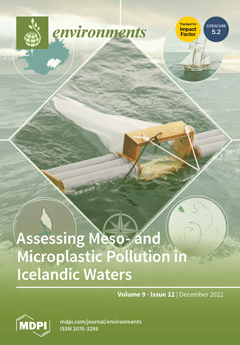Groundwater of northern Mexico contains high concentrations of geogenic fluoride (F
−), a contaminant known to affect human health. The origin of F
− in groundwater in this region has been related to the weathering of rhyolite and other volcanic rocks present
[...] Read more.
Groundwater of northern Mexico contains high concentrations of geogenic fluoride (F
−), a contaminant known to affect human health. The origin of F
− in groundwater in this region has been related to the weathering of rhyolite and other volcanic rocks present in the alluvium. However, the relationship of F
− concentration to water depth has not been established. F
− concentrations, pH, and total dissolved solids (TSD) were determined for 18 wells within the Meoqui-Delicias aquifer in 2021. The F concentrations varied between 0.62 mg L
−1 and 4.84 mg L
−1, and 61% of the wells exceeded the 1.5 mg L
−1 guideline. F
− concentrations did not correlate to TDS but correlated to well depth (r = −0.52,
p < 0.05). Because of the less-than-strong correlation coefficient value obtained, a diagram of F
− concentrations vs. well depth was constructed. The diagram showed a distinct enrichment of F
− in shallow wells, suggesting that groundwater residence time and evaporation may be important factors in explaining the F
− content within the aquifer. This pattern was confirmed after plotting 2003 and 2006 data for the same wells. These findings are important to better understand the distribution of F
− in neighboring alluvial aquifers as well as in alluvial aquifers elsewhere.
Full article





